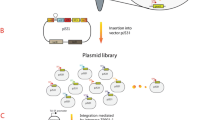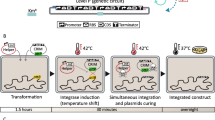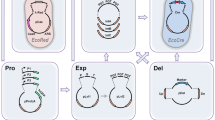Abstract
A linker-based approach for combinatorial assembly of promoter and gene cassettes into a biochemical pathway is developed. A synthetic library containing 144 combinations, with 3 promoters and 4 gene variants, was constructed for the ackA and pta genes of the acetate utilization pathway in E. coli. The in vitro isothermal assembled library was then introduced into E. coli mutant (acs-, pta-, ackA-) and selected for restoration of acetate utilization. 81% of the colonies screened contained the complete functional pathway. Thirty positive clones were analyzed and accounted for 10% of the 144 promoter–gene combinations.


Similar content being viewed by others
References
Alper H, Fischer C, Nevoigt E, Stephanopoulos G (2005) Tuning genetic control through promoter engineering. PNAS USA 102:12678–12683
Chatterjee R, Yuan L (2006) Directed evolution of metabolic pathways. Trends Biotechnol 24:28–38
Gibson DG et al (2008) One-step assembly in yeast of 25 overlapping DNA fragments to form a complete synthetic Mycoplasma genitalium genome. PNAS USA 105:20404–20409
Gibson DG, Young L, Chuang RY, Venter JC, Hutchison CA, Smith HO (2009) Enzymatic assembly of DNA molecules up to several hundred kilobases. Nat Methods 6:341–345
Harley CB, Reynolds RP (1987) Analysis of E. coli promoter sequences. Nucleic Acids Res 15:2343–2361
Henke E, Bornscheuer UT (1999) Directed evolution of an esterase from Pseudomonas fluorescens. Random mutagenesis by error-prone PCR or a mutator strain and identification of mutants showing enhanced enantioselectivity by a resorufin-based fluorescence assay. Biol Chem 380:1029–1033
Hermes JD, Blacklow SC, Knowles JR (1990) Searching sequence space by definably random mutagenesis––improving the catalytic potency of an enzyme. PNAS USA 87:696–700
Johannes TW, Zhao HM (2006) Directed evolution of enzymes and biosynthetic pathways. Cur Opin Microbiol 9:261–267
Li MZ, Elledge SJ (2007) Harnessing homologous recombination in vitro to generate recombinant DNA via SLIC. Nat Methods 4:251–256
Lu CF, Mansoorabad K, Jeffries T (2007) Comparison of multiple gene assembly methods for metabolic engineering. Appl Biochem Biotechnol 137:703–710
Nevoigt E, Kohnke J, Fischer CR, Alper H, Stahl U, Stephanopoulos G (2006) Engineering of promoter replacement cassettes for fine-tuning of gene expression in Saccharomyces cerevisiae. Appl Environ Microbiol 72:5266–5273
Pachuk CJ, Samuel M, Zurawski JA, Snyder L, Phillips P, Satishchandran C (2000) Chain reaction cloning: a one-step method for directional ligation of multiple DNA fragments. Gene 243:19–25
Quan JY, Tian JD (2009) Circular polymerase extension cloning of complex gene libraries and pathways. PLOS-One 4:6
Shao ZY, Zhao H, Zhao HM (2009) DNA assembler, an in vivo genetic method for rapid construction of biochemical pathways. Nucleic Acid Res 37:10
Stemmer WPC (1994) DNA shuffling by random fragmentation and reassembly—In vitro recombination for molecular evolution. PNAS, USA 91:10747–10751
Tsuge K, Matsui K, Itaya M (2003) One step assembly of multiple DNA fragments with a designed order and orientation in Bacillus subtilis plasmid. Nucleic Acid Res 31:8
Warming S, Costantino N, Court DL, Jenkins NA, Copeland NG (2005) Simple and highly efficient BAC recombineering using gaIK selection. Nucleic Acid Res 33:12
Wong QNY, Ng VCW, Lin MCM, Kung HF, Chan D, Huang JD (2005) Efficient and seamless DNA recombineering using a thymidylate synthase A selection system in Escherichia coli. Nucleic Acid Res 33:9
Acknowledgment
This work was supported by Synthetic Genomics, Inc (SGI).
Conflict of interest
H.O.S. is Co-Chief Scientific Officer, a member of the Board of Directors of SGI, and holds stock in SGI.
Author information
Authors and Affiliations
Corresponding author
Electronic supplementary material
Below is the link to the electronic supplementary material.
Rights and permissions
About this article
Cite this article
Ramon, A., Smith, H.O. Single-step linker-based combinatorial assembly of promoter and gene cassettes for pathway engineering. Biotechnol Lett 33, 549–555 (2011). https://doi.org/10.1007/s10529-010-0455-x
Received:
Accepted:
Published:
Issue Date:
DOI: https://doi.org/10.1007/s10529-010-0455-x




